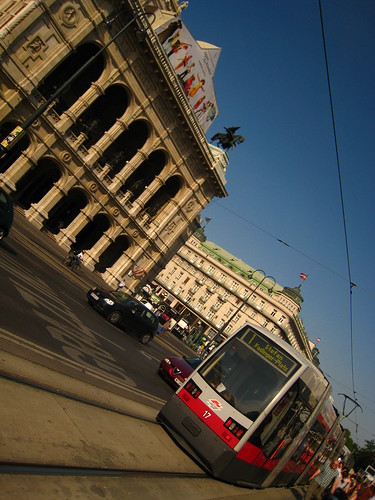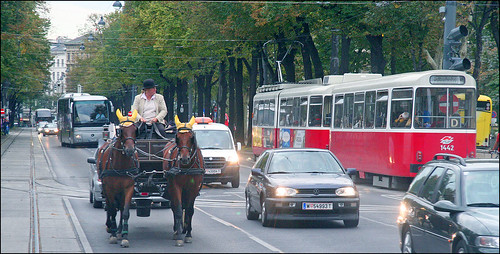Today, Vienna shows an unusual arrangement of the monuments the visitor awake: the relatively small center of town (Innere Stadt), clustered around the old cathedral of St. Stephen, is surrounded by a large ring of very broad spaces, full gardens and majestic buildings of the nineteenth century, and beyond this ring is another major monuments of the eighteenth century.

Photography by Harshil.Shah
History:
This particular plane as explained by the massive fortifications that surrounded the old city during the Middle Ages and the Renaissance. The fortifications were built in the sixteenth century Venetian in patterns, not only consisted of walls, but also bastions, ramps, and a large pit.
Responded to the need to fortify the city better, and in 1529 she suffered the first Turkish siege by the army of the Sultan’s most famous history of the Ottoman Empire, Suleiman I the Magnificent. The weather of that year and poor preparation prevented the capture of the city, but it became clear that Suleiman I was determined to take Vienna later, it would not be very difficult at times defensive conditions.
In the early eighteenth century, after the failed and dramatic new assault of the Turks in 1683, which slowed the expansion of the Ottoman Empire into Europe, Vienna regained its population and expanded as never before, and had to expand. The settlements outside the fortifications were threatened by new tumultuous times because of a Hungarian peasant revolt (Kurocok, 1703-1711), why he had to build a new system of fortifications around the first, so here we would have our second ring around.
Places to visit:
In 1857, Emperor Franz Joseph I approved a plan to unify the two parts of Vienna by pulling to ground the old walls and building modern buildings and extensive gardens. It took more than 30 years to complete the reform agenda that the architects took to build the magnificent buildings we see today in neo-Renaissance architecture, Gothic Revival and Neoclassical. There was even room for a palace built in neo-Tudor. These mixes of architectural styles are often referred to as «Ringstrassenstil.» The use of styles in the new building had its meaning: the museums (the Art and Natural History, for example) and the State Opera House are based on an Italian Renaissance style, while the Parliament of Austria based on the style of classical Greece, with a clear wink to the birthplace of democracy.

Photography by roblisameehan
It was built as a grand avenue (Ringstrasse) 4 km in length, which completely surrounds the city center. To this end, brought down the ramparts, glacis (military training area) and other protections already in disuse. The Ringstrasse was generously planned, leaving enough room for a wide avenue lined with monumental buildings like Hofburg, Austrian Parliament, the State Opera House, the Museum of the Arts, the first public observatory Urania and the University of Vienna, between others.
The Ringstrasse was ceremoniously opened May 1, 1865 by the emperor, and is one of the most beautiful and wide boulevards of the world.

Photography by budgetplaces.com
The fortifications of the second ring be thrown to the ground years later. However, we can still see something of the old bastions if you look at the steps that connect different levels of ground in these wide spaces of the first defensive ring of Vienna (now Burgring), or spotted markings modern buildings that commemorate events the siege of Vienna in 1683, besides that still stand around the wall that is not wanted down to preserve historic buildings.
Walking along the Ringstrasse:
The most interesting areas are the Opern Riingo Ringstrasse; Karntner Ring, Ring and Burg Doktor Karl Renner Ring & Lueger Ring. If you do not have much time in our wanderings through the center of Vienna, not worth visiting Schottenring, but go first mentioned areas is a pleasure, both day and evening.
Tips:
Keep in mind that throughout this vast area there are few areas of restoration and trade, making it ideal for travel during the morning or after eating in other parts of the city. In the gardens of Volksgarten yes there are any other dining options, but be careful because the prices are sky high and we may have an unpleasant surprise to read the bill. In contrast, Burg Ring stalls are perfect for eat a warm slice of pizza or muffins, coffee, water, etc. at very affordable prices. We have one just outside metro Volksgarten Theatre.
If possible, climb into one of the old trams that circulate Ringstrasse as well as offer a fantastic panorama of the monuments and areas of the city center is also inspiring to see how well this transport remains so old.

Photography by dicktay2000
Good Luck!
One Response to “The historic Ringstrasse in Vienna”
Leave a Reply
You must be logged in to post a comment.
agosto 9th, 2016 at 9:09 am
Hi there, this weekend is ggood in support of me, for the
reason tgat this occasion i am reading this fantastic educational paragraph here aat my house.